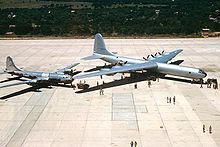7th Operations Group
The 7th Bombardment Group was deploying to the Philippines when the Imperial Japanese Navy Air Service attacked Pearl Harbor on 7 December 1941.Six of the group's B-17 Flying Fortress aircraft which had left Hamilton Field, California on 6 December 1941 reached Hawaii during the enemy attack, but were able to land safely.The 7 OG (Tail Code: DY) consists of the following units: Both the 9th and 28th Bomb Squadrons fought in combat on the Western Front of World War I, and histories predate that of the Operations Group.Aircraft from the group took numerous air photos and compiled maps of enemy troop concentrations, road convoys, railway traffic, artillery and other targets during the Battle of Saint-Mihiel in mid-September.With the Armistice with Germany being reached on 11 November 1918, the group ceased flying into enemy territory, but maintained an alert for several weeks afterward.[4] The 7th trained and participated in aerial reviews, assisted in atmospheric experiments, dropped food and medical supplies to people marooned or lost, and took part in massive Army maneuvers during the 1930s flying Curtiss and Keystone biplane bombers, then Martin B-12s,[4] For 102 days in 1934 the Army Air Corps flew domestic air mail routes, assigned to the job by an executive order from the White House.This followed a year long investigation that alleged fraud and collusion among the dozen or so airlines who hauled the mail for a subsidy of fifty four cents per mile flown.Equipped with the new B-17C in 1939, runway issues at Hamilton Field forced a transfer to Fort Douglas/Salt Lake City Municipal Airport, Utah on 1 September 1940 which could better handle the large, heavy bombers.In Utah, the group was re-equipped with the B-17E – the first Fortress to introduce a completely new rear fuselage with a manually operated turret housing two 0.50-inch machine guns fitted in the extreme tail.The air echelon moved its B-17Es via North Africa and India to Java, where from 14 January to 1 March 1942, it operated against the Japanese advancing through the Philippines and Netherlands East Indies.Ceased bombing operations in late May 1945 and was attached to the Air Transport Command to haul gasoline over "The Hump" from India to China.During their ten-day stay, the group bombers participated in training operations over Europe, as well as a show-of-force display by the United States in the early part of the Cold War with the Soviet Union.On 17 November 1947, the 7th Bombardment Wing was established to organize and train a force capable of immediate and sustained long range offensive warfare and operations in any part of the world.For 10 years, the "Peacemaker" cast a large shadow on the Iron Curtain and served as our nations major deterrent weapons system.A five ship B-36 formation was flown on 15 January 1949, in an air review over Washington, D.C., commemorating the inauguration of the President of the United States, Harry S. Truman.In February 1949, a B-50 Superfortress (developed from the famed B-29) and named Lucky Lady II took off from Carswell Air Force Base for the first nonstop flight around the world.The aircraft, staging through Limestone AFB, Maine, would land at RAF Lakenheath, United Kingdom, following a night radar bombing attack on Helgoland, West Germany.



B-1B LancerJoint Air-to-Surface Standoff MissileWhite Sands Missile RangeUnited StatesUnited States Air ForceUnited States ArmyArmy Air ForcesArmy Air CorpsArmy Air Service7th Bomb WingDyess Air Force BaseWorld War ISt. MihielMeuse-ArgonneWorld War II – Asiatic-Pacific TheaterEast IndiesIndia-BurmaChina DefensiveCentral BurmaChina OffensiveDistinguished Unit CitationAir Force Outstanding Unit AwardBomberB-1 LancerWorld War IIPhilippinesImperial Japanese Navy Air ServicePearl HarborB-17 Flying FortressHamilton FieldStrategic Air CommandB-29 Superfortress9th Bomb Squadron28th Bomb Squadron436th Training SquadronWestern Front24th Aero SquadronFirst Army Observation GroupGondreville-sur-Moselle Aerodrome24th Aero SquadronsBattle of Saint-MihielVavincourt Aerodrome9th Aero SquadronLangley Field88th Aero Squadronsde Havilland DH-4sUnited States Army Air ServiceRockwell FieldMaltese CrossesMarch FieldCurtiss B-2Keystone B-4CurtissKeystoneMartin B-12sYogyakartaJapanese attacked Pearl HarborPacific CoastBrisbaneNetherlands East IndiesMoulmeinB-24 LiberatorsTenth Air ForceB-25 MitchellsThailandAndaman SeaAir Transport CommandThe HumpBoeingCarswell Air Force Base92nd Bombardment GroupSpokane AAFldWashingtonCarswellYokota ABAleutian IslandsAnchorageAlaskaEdmontonMinnesotaWisconsinThe PentagonWashington MonumentWürzburgWest GermanyCold WarSoviet UnionConsolidated B-36A Peacekeeper97th Bomb GroupBiggs AFBHarry S. TrumanB-50 SuperfortressLimestone AFBRAF LakenheathHelgolandHestonOperation Desert Fox2d WingNinth Corps Area1st Bombardment Wing1st Wing20th Bombardment WingII Bomber CommandV Bomber CommandNew York Port of EmbarkationFifteenth Air ForceEighth Air Force7th Bombardment Wing7th (later, 7th Bomb) Wing91st Aero Squadron186th Aero Squadron1st Aero Squadron11th Bombardment Squadron12th Aero Squadron31st Bombardment Squadron50th Aero Squadron95th Pursuit Squadron88th Aero Squadron436th Bombardment Squadron14th Bombardment Squadron22d Bombardment Squadron32d Bombardment Squadron492d Bombardment Squadron493d Bombardment Squadron7th Air Refueling Squadron13th Bomb Squadron
